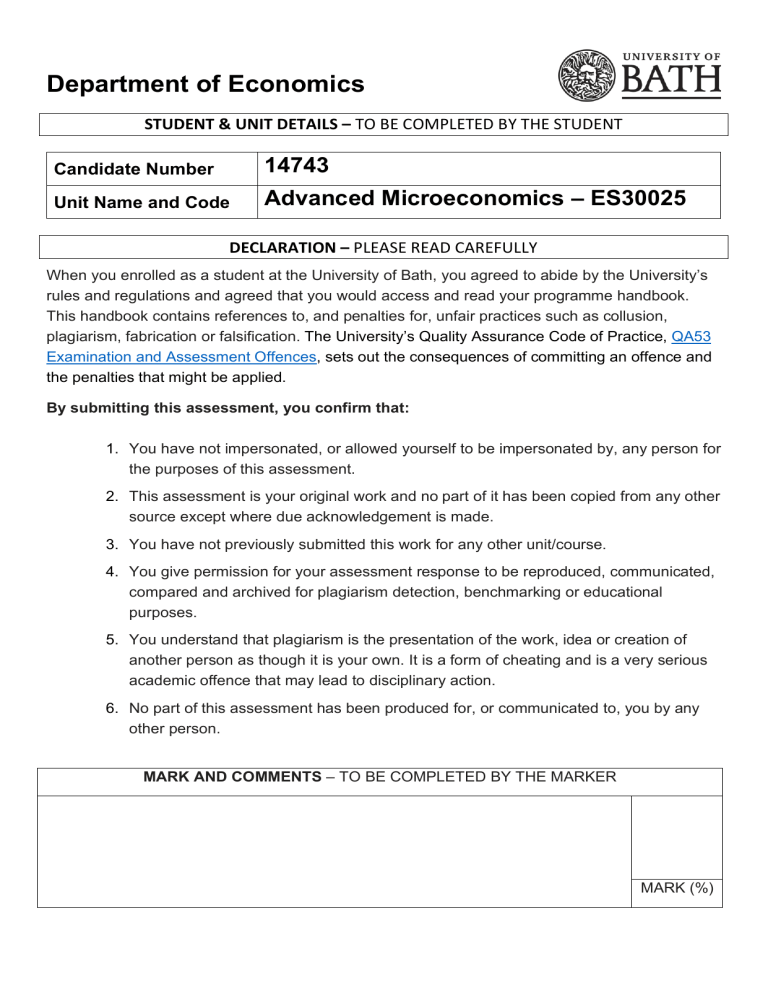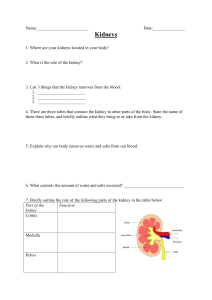
Department of Economics STUDENT & UNIT DETAILS – TO BE COMPLETED BY THE STUDENT Candidate Number 14743 Unit Name and Code Advanced Microeconomics – ES30025 DECLARATION – PLEASE READ CAREFULLY When you enrolled as a student at the University of Bath, you agreed to abide by the University’s rules and regulations and agreed that you would access and read your programme handbook. This handbook contains references to, and penalties for, unfair practices such as collusion, plagiarism, fabrication or falsification. The University’s Quality Assurance Code of Practice, QA53 Examination and Assessment Offences, sets out the consequences of committing an offence and the penalties that might be applied. By submitting this assessment, you confirm that: 1. You have not impersonated, or allowed yourself to be impersonated by, any person for the purposes of this assessment. 2. This assessment is your original work and no part of it has been copied from any other source except where due acknowledgement is made. 3. You have not previously submitted this work for any other unit/course. 4. You give permission for your assessment response to be reproduced, communicated, compared and archived for plagiarism detection, benchmarking or educational purposes. 5. You understand that plagiarism is the presentation of the work, idea or creation of another person as though it is your own. It is a form of cheating and is a very serious academic offence that may lead to disciplinary action. 6. No part of this assessment has been produced for, or communicated to, you by any other person. MARK AND COMMENTS – TO BE COMPLETED BY THE MARKER MARK (%) START YOUR ASSESSMENT HERE. BEFORE YOUR ANSWERS, STATE EXPLICITLY WHICH PART / QUESTION / SUBQUESTION YOU ARE ATTEMPTING. 1. Using the Top Trading Algorithm with Chains, we begin our first step as follows: Each patient points to his preferred kidney, and each kidney points to the patient it is endowed to. Following Stage 1, we can see that there are no cycles, only chains. Therefore, we select a chain using chain rule c and allocate kidneys accordingly. With chain rule c, we select the longest chain, allocate the kidneys to the patient pointing at them and keep the donor/ patient pairs in the problem. In this case, the longest chain is (𝑘7 → ⋯ → 𝑤), highlighted green. So, the kidney assignments from Stage 1 are: (𝑃2 , 𝑘11 ), (𝑃4 , 𝑘9 ), (𝑃5 , 𝑤), (𝑃7 , 𝑘4 ), (𝑃9 , 𝑘2 ), (𝑃11 , 𝑘5 ) As we still have unassigned pairs, we move to Stage 2. Page 2 of 12 Following Stage 2, we find a chain (𝑘1 → ⋯ 𝑃12 → 𝑘1 ), highlighted orange. As with the standard TTC, we allocate the kidneys to the patients pointing at them and remove pairs from the process. The assignments from Stage 2 are therefore: (𝑃1 , 𝑘3 ), (𝑃3 , 𝑘12 ), (𝑃12 , 𝑘1 ) As we still have unassigned pairs, we move to Stage 3. Following Stage 3, we find another cycle (𝑘6 → ⋯ 𝑃12 → 𝑘6 ). The assignments at Stage 3 are therefore: (𝑃6 , 𝑘10 ), (𝑃10 , 𝑘6 ) As we still have an unassigned pair, we move to Stage 4. Page 3 of 12 As we still have our original chain in the problem, patient 8 points at kidney 7 and extends the original chain. Therefore, the assignment from Stage 4 is: (𝑃8 , 𝑘7 ) All patients have either been assigned kidneys or have been added to the waiting list, so the algorithm ends. The final allocations are: (𝑃1 , 𝑘3 ) (𝑃2 , 𝑘11 ) (𝑃3 , 𝑘12 ) (𝑃4 , 𝑘9 ) (𝑃5 , 𝑤) (𝑃6 , 𝑘10 ) (𝑃7 , 𝑘4 ) (𝑃8 , 𝑘7 ) (𝑃9 , 𝑘2 ) (𝑃10 , 𝑘6 ) (𝑃11 , 𝑘5 ) (𝑃12 , 𝑘1 ) Page 4 of 12 2. Using the Top Trading Algorithm with Chains, we begin our first step as follows: Each patient points to his preferred kidney, and each kidney points to the patient it is endowed to. Following Stage 1, we can see that there are no cycles, only chains. Therefore, we select a chain using chain rule f and allocate kidneys accordingly. With chain rule f, we prioritize pairs with the type O donor, and choose the chain that starts with the highest priority pair. We then allocate the kidneys to patients pointing at them and remove them from the problem. In this case, the highest priority type O donor is 𝑃1,𝑘1, so the chain begins here. The full chain is 𝑘1→…→𝑤, highlighted green. So, the kidney assignments from Stage 1 are: (𝑃1 , 𝑘2 ), (𝑃2 , 𝑘11 ), (𝑃5 , 𝑤), (𝑃11 , 𝑘5 ) As we still have unassigned pairs, we move to Stage 2 Page 5 of 12 Following Stage 2, we observe a cycle highlighted orange, and therefore assign kidneys to the patients pointing at them and remove the pairs from the problem. The kidney assignments from Stage 2 are: (𝑃6 , 𝑘10 ), (𝑃10 , 𝑘6 ) As we still have unassigned pairs, we move to Stage 3 Again, we observe a cycle highlighted purple, assign the kidneys and remove the pairs from the problem. The assignments are: (𝑃3 , 𝑘12 ), (𝑃9 , 𝑘3 ), (𝑃12 , 𝑘9 ) We still have unassigned pairs, so move to the next stage: Page 6 of 12 Finally, we are left with a chain, so we allocate kidneys to the patient pointing at them and patient 4 is allocated to the waiting list. The allocations from Stage 4 are: (𝑃4 , 𝑤), (𝑃7 , 𝑘4 ), (𝑃8 , 𝑘7 ) All patients have either been assigned kidneys or have been added to the waiting list, so the algorithm ends. The final allocations are: (𝑃1 , 𝑘2 ) (𝑃2 , 𝑘11 ) (𝑃3 , 𝑘12 ) (𝑃4 , 𝑤) (𝑃5 , 𝑤) (𝑃6 , 𝑘10 ) (𝑃7 , 𝑘4 ) (𝑃8 , 𝑘7 ) (𝑃9 , 𝑘3 ) (𝑃10 , 𝑘6 ) (𝑃11 , 𝑘5 ) (𝑃12 , 𝑘9 ) Page 7 of 12 3. When using the TTCC algorithm, there is either a cycle or a chain at the end of each stage. Firstly, let’s prove the existence of a cycle in the event that there is no patient preferring the waiting list to receiving a kidney. Consider a diagram where each patient ‘points’ to a kidney and each kidney points to a patient, as we see above. Donor/ patient pairs in this case are denoted (𝑘, 𝑡), where kidney 𝑘 points to patient 𝑡. Each node in this diagram points to another and, given that there are a finite number of kidneys, a kidney must be encountered twice. Suppose 𝑘 is this kidney, with 𝑡 pointing to 𝑘. The path starting with kidney 𝑘 and ending with the patient 𝑡 is a cycle. Now suppose there is no cycle, which is possible under TTCC where a patient points to the waiting list. Consider a diagram now where each patient t points to kidney 𝑘 or the waiting list 𝑤. Let’s consider a donor/ patient pair (𝑘’, 𝑡’). If we follow the path of the diagram starting from kidney 𝑘’, the path will terminate at 𝑤. This is because no cycle exists, meaning a kidney cannot be encountered twice. Given that the number of donor/ patient pairs, the path must end at 𝑤 – therefore a chain exists from (𝑘’, 𝑡’) to 𝑤. Page 8 of 12 4. An algorithm is not strategy-proof if any individual can benefit by misrepresenting their preferences, giving them a superior outcome. In the TTCC mechanism, strategy-proofness depends on the chain rule that is chose. Rule c is not strategy-proof, and this relates to the length of the chain being the longest possible. A patient can affect their kidney assignment by affecting the length of the chain by misrepresenting their preferences. To prove that rule c is not strategy-proof, we only need to provide one example of an individual benefitting (obtaining a more preferable kidney) from misrepresenting their preferences. The following proof will suffice. Let’s prove this using question 1. With truthful preferences, the first longest chain is (𝑘7 → ⋯ → 𝑤), highlight green below. In Stage 3, patient 6 is allocated kidney 10 (𝑃6 , 𝑘10 ) This is with his preferences of: (𝑘11 , 𝑘1 , 𝑘10 , 𝑘3 , 𝑘5 , 𝑤) Page 9 of 12 Suppose patient 6 misrepresents his preferences by moving 𝑘1 up in the order such that: (𝑘1 , 𝑘11 , 𝑘10 , 𝑘3 , 𝑘5 , 𝑤) The longest chain at Stage 1 is then tied between (𝑘7 → ⋯ → 𝑤) highlighted green as above, and (𝑘10 → ⋯ → 𝑤). Suppose (𝑘10 → ⋯ → 𝑤) is chosen by randomization such that: In this scenario, patient 6 will be allocated kidney 1, a more favorable choice for his preferences. Patient 6 has gained a more preferable outcome by misrepresenting his preferences, so chain rule c is not strategy-proof. Page 10 of 12 5. Chain rule ‘a’ is strategy-proof, and the reason lies in the nature of strategy. Patients can no longer created a longer chain as with rule ‘c’, and this limits their ability to create a more favorable kidney allocation. We will first consider this proof theoretically and then mathematically. Under chain rule ‘a’, the shortest chain is selected, and donor/ patient pairs are allocated and removed from the problem. That is, the patient(s) pointing at the waiting list are removed first. Consider a patient who wants to misrepresent their preferences in order to gain a more preferable order in the algorithm. There are two strategies for this: i) ii) Point to the waiting list and be assigned there, which of course is always less preferable than point to a preferred kidney, and therefore never incentivised Point to a kidney further ahead in the chain and create a cycle We know strategy i is strategy-proof. For strategy ii, the patient removes the influence of waiting lists, similar to that of the general TTC algorithm used with simple matching problems. With the TTCC algorithm with rule c, the only way for patients to be allocated to a kidney and not the waiting list is through cycles resembling the TTC algorithm. We know according to Roth (1982)1 that the TTC algorithm is strategy-proof because any attempt to misrepresent preferences either: - Creates a new cycle, where our patient will be allocated the less favourable kidney intended to misrepresent his preferences, or Create no new cycle, where our patient is again allocated the less favourable kidney Clearly either of these outcomes is less preferable than being truthful about preferences and being assigned the preferred kidney. Let us consider the problem mathematically: Consider a preference profile (𝑃𝑖 )𝑛𝑖=1 . Now form a new preference profile (𝑃𝑖′ )𝑛𝑖=1 using the following rules: For each patient 𝑡𝑖 that prefers any kidney to the waiting list 𝑘𝑖 𝑃𝑖 𝑤, let 𝑃𝑖′ = 𝑃𝑖 . For each patient 𝑡𝑖 that prefers the waiting list to any kidney 𝑤𝑃𝑖 𝑘𝑖 , form 𝑃𝑖′ by swapping the ranking of 𝑘𝑖 and 𝑤. It can now be said that 𝑘𝑖 𝑃𝑖′ 𝑤 for each patient 𝑡𝑖 . Under preferences 𝑃𝑖′ , suppose a matching mechanism 𝜇 assigns kidneys to patients. We want to consider the matching mechanism of TTCC using chain rule a. For this, we use notation 𝑣: If 𝑃𝑖′ ≠ 𝑃𝑖 and 𝜇 (𝑡𝑖 ) = 𝑘𝑖 , then 𝑣(𝑡𝑖 ) = 𝑤, otherwise 𝑣 (𝑡𝑖 ) = 𝜇 (𝑡𝑖 ). That is, any patient that preferred the waiting list over a kidney is assigned to the waiting list under TTCC with chain rule a, and any Page 11 of 12 patient that preferred a kidney to the waiting list is assigned that kidney. Under the TTCC algorithm, a patient will never be assigned a kidney that is inferior to the waiting list. So, while a patient can misrepresent their preferences and get on the waiting list, this will never be preferred to being truthful about his preferences and being assigned a kidney. [1] Roth, A. 1982. ‘The Economics of Matching: Stability and Incentives’. Mathematics of Operations Research, Vol. 7, No. 4 (Nov., 1982), pp. 617-628 Page 12 of 12





